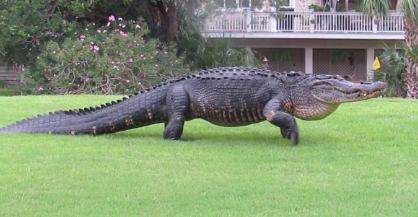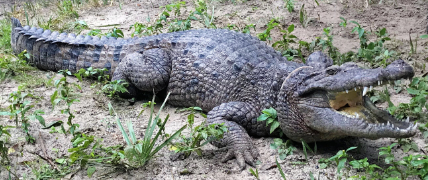Alligator
The Alligator referred colloquially as gator are amazing animals that have been around for millions of years. Alligators are in the same family as other large reptiles like crocodile but are native to only two countries, which are the southern USA and China. The American alligator are found in the South-eastern USA, throughout all of Florida and Louisiana, the southern parts of Georgia, Alabama and Mississippi, coastal south and North Carolina, eastern Texas, the south-eastern corner of Oklahoma and Arkansas.

Alligator is a solitary predator that is actually surprisingly clunky when moving about on land. They tend to be quite slow, moving themselves by either crawling or sliding along the slippery banks on their bellies.
Alligator are known to be highly territorial animals that make a variety of noises to represent different things, including the declaration of territory, finding a mate and the young warning their mother that they are in danger. An alligator is an apex predator in its environment, known to even hunt animals that are much larger in size.
There are two extant species of alligators that is, the Chinese alligator (Alligator Sinesis) and the American Alligator (Alligator Mississippiensis).
What You Need To Know About Alligator
- Alligators are native only to China, mostly in the Yangtze River and the United States, particularly Florida and Louisiana.
- There are two extant species of alligators including the Chinese alligator (Alligator Sinesis) and the American Alligator (Alligator Mississippiensis).
- Alligators have wide U-shaped snouts.
- Alligator have a dark complexion.
- The biggest alligator weighs averagely 1000 pounds.
- They are smaller in length than crocodiles. They can grow upto an average length of 4.5 meters.
- Hatchlings have an average length of between 15 and 20 centimeters.
- The average lifespan of an alligator is usually between 30-50 years.
- Alligator are mostly found in warmer climates and freshwater environment such as swamps, lakes and rivers.
- Alligators eat everything from birds to fish to other reptiles, small mammals and even fruits.
- Alligators start mating in the late spring and continue into summer (April-June).
- Alligator lay an average of 20-50 eggs per batch.
- The extinction threat facing crocodiles is hunting by humans for skin, the loss of their habitat and contamination of their food from pesticides.
- Alligator are instinctively afraid of humans but can lose some of that fear if they are unexpectedly disturbed, provoked or when it comes to defending their young ones.
- Alligators have a bite pressure (strength) of about 2700 pounds per inch.
- For alligator, no teeth are visible at the bottom of their mouth when their snouts are closed.
- Alligators are faster in water when compared to crocodiles; they can reach the maximum speed of 20mph.
- Chinese alligators are generally considered critically endangered. There are less than 200 Chinese alligators in existence.
- At any given time an average mature alligator can have up to 80 teeth.
- Seamless swimmers with ability to navigate water undetected.
- Sex of the hatchlings is dependent on the average temperature at certain times during egg incubation
- For incubation, eggs are normally hidden near water bodies and stay heavily guarded by mature male and female crocodiles.
Crocodile

Crocodiles are large semi-aquatic reptiles that live throughout the tropics in Africa, Asia, the America and Australia. Crocodiles are highly carnivorous and formidable predators at the top of the food chain in their natural environments. They are members of the order Crocodilia, which also includes Caimans, Gharials and alligator. Today, there are 13 different crocodile species that are found inhabiting both fresh and saltwater environments throughout the world. Their Semi-aquatic nature has led to them evolving a number of key adaptations that allow them to survive so successfully in their natural environments.
Crocodile’s powerful bodies, strong jaws and immense speed and agility along with their unparalleled stealth, has resulted to them being one of the world’ most apex predators in their natural environments. Crocodiles have scaly skin that is made up of armoured, waterproof plates that booth protects them from potential predators and also prevents their bodies from drying out. These scales come in a variety of colors from dull olive and green, to brown, grey and black meaning that they are very easily camouflaged in the surrounding water and vegetation.
Just like other reptiles, crocodiles are not able to regulate their body temperature themselves and instead rely heavily on the heat of the sun to warm up their enormous bodies. During the hot daytime hours, they bask in the sun on the riverbanks warming their bodies up from a night of hunting.
What You Need To Know About Alligator
- Other than Europe and Antarctica, Crocodiles are found almost everywhere around the world. The largest populations of crocodiles can be found in Central Africa (Nile crocodile) and Asia (Borneo, saltwater crocodile).
- Crocodiles snouts are long, narrow and pointed in other words the snouts are V-shaped.
- Crocodiles appear light brown, green or gray.
- The largest crocodile species (saltwater crocodiles) can weigh averagely 2000 pounds.
- They are larger in length than alligators. They can grow up to 6.2 meters.
- The smallest species of crocodile (dwarf crocodiles) can measure about 5.5 feet in length and weigh about 14 to 20 pounds.
- The average lifespan of a crocodile is between 70-100 years.
- Crocodiles can live in both freshwater and saltwater habitats. Their adaptability makes them more likely to be found throughout the world. Crocodiles have evolved special glands on their tongues which help them excrete excess salt from their bodies.
- Crocodiles eat frogs, birds, fish, gazelles, crustaceans (crab) and large mammals (wildebeest and zebras).
- Crocodiles don’t begin mating until the summer months (July-August).
- Crocodiles lay an average of 10-60 eggs per batch.
- The extinction threat facing alligators is climate change. Climate change threatens the freshwater habitats of alligators as the rise in sea levels can contaminate fresh water sources with salt water.
- Crocodiles are much more bad-tempered and far more likely to attack humans, even unprovoked.
- Crocodiles have a bite pressure of about 3700 pounds per square inch. Therefore, in terms of aggression, crocodiles will win any fight against alligator.
- The crocodile’s lower teeth are predominantly visible. This means that crocodiles have several teeth sticking above their lips which give them a very jagged smile.
- Crocodiles are slow in water; their average speed is 9mph.
- Cuban, Orinoco and Philippine crocodiles are generally considered critically endangered.
- At any given time an average mature crocodile can have upto 68 teeth.
- Sex of the hatchlings is dependent on the average temperature at certain times during egg incubation.
Also Read: Difference Between Bobcat And Mountain Lion
Difference Between Crocodile And Alligator In Tabular Form
| BASIS OF COMPARISON | ALLIGATOR | CROCODILE |
| Kingdom | Animalia | Animalia |
| Phylum | Chordata | Chordata |
| Class | Reptilia | Reptilia |
| Order | Crocodilia | Crocodilia |
| Family | Alligatoridae | Crocodylidae |
| Genus | Alligator | Crocodylus, Osteolaemus, Mecistops. |
| Scientific Name | Alligator Mississippiensis | Crocodylus acutus, Crocodylus niloticus, crocodylus palustris, Osteolaemus tetraspis, crocodylus johnsoni , Mecistops cataphractus, crocodylus siamensis etc |
| Other Names | Gator | Crocodile, Croc. |
| Group | Reptile | Reptile |
| Number of Species | 2 | 13 |
| Location | Southern USA and China. | North, Central and South America, Africa, Asia, Australia. |
| Habitats | Marsh and Swampland. | Rivers, lakes, marshes, lagoons, mangrove swamps and estuaries. |
| Color | Alligator have a dark, grey, black or dull olive complexion. | Crocodiles appear light brown, green or gray. |
| Snout | V-shaped | U-shaped |
| Skin Type | Scales | Plate-like scales. |
| Size (Length) | 2.5m-4.5m (8ft-18ft) | 1.7m-7m (5.5 ft-23ft) |
| Weight | 181-400kg (400lbs-1000lbs) | 18-1000kg (40lbs-2100lbs). |
| Diet | Carnivore | Carnivore |
| Average Speed | 20mph. | 9mph. |
| Teeth | Concealed | Exposed. |
| Tail | Strong tail | Strong tail |
| Skin | Thick skin | Thick skin |
| Habitat | Freshwater | Saltwater |
| Behavior | Can be aggressive, less aggressive or docile. | Always aggressive. |
| Temperature Regulation | Cold-blooded | Coldblooded. |
| Feet | Webbed feet | Web feet |
| Prey | Fish, snake, fruits, turtles etc | Fish crustaceans, deer, buffalo |
| Predators | Humans, Birds, Raccoon etc | Humans, large felines, Birds of prey. |
| Lifestyle | Diurnal/Nocturnal. | Nocturnal |
| Group Behavior | Solitary | Social |
| Lifespan | 30-60 years | 20-70 years |
| Age of Sexual Maturity | 10-12 years | 4-12 years |
| Reproduction Mechanism | Lay Eggs | Lay Eggs |
| Incubation Period | 2 month | 3 month |
| Average Clutch size | 17-100 | 35 |
| Name of Young one | Hatchling | Hatchling |
| Age Of Independence | 1-2 years | 1-2 |
| Conservation Status | Least concerned, critically endangered. | Least concern, vulnerable, critically endangered. |
| Fun Fact | They have no tongue They have two sets of eyelids. | Known to eat pebbles to aid digestion and buoyancy. They have no tongue |
| Estimated Population Size | Less than 0.5 million | Unknown |
| Extinction Threat | Water pollution | Habitat loss and hunting |
| Most Distinctive Feature | Muscular tail, half the total body length. | Eyes and nostrils located on top of the head and snout. |
What Are Some Of The Similarities Between Crocodiles And Alligators?
- Both crocodiles and alligators are reptiles from the same order crocodilia.
- They have four limbs with ears, nostrils and eyes that sit on top of their heads.
- Crocodiles and alligators are not closely related in such a way that they can interbreed.
- Both crocodile and alligator are cold-blooded and use their environment to help regulate their body temperature e.g by slipping into the shade or water to cool down.
- Both have powerful jaws with powerful muscles for closing and weak muscles for opening.
- Both crocodile and Alligator have an extremely heightened sense, which makes them excellent hunters.
- Both have webbed feet.
- They are both much more agile and fast in water where they use their long, muscular tails to propel their bodies forward.
- Both alligator and crocodile are carnivores with slow metabolism.
- Both animals have small sensory pits along their jaws that allow them to detect pressure changes in water and to locate and capture prey.
- Both animals can run on land reaching average speeds of about 11 miles per hour.
- Both alligator and crocodiles can lay dozens of eggs at a time.